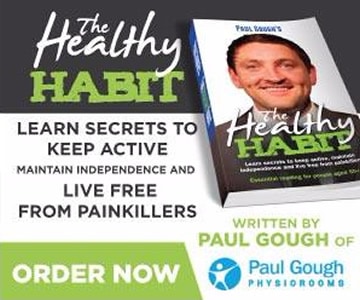More fitness tips for “weekend athletes” when you look here: www.paulgoughphysio.com/sports-injury-clinic
This interesting comment came in from a member of a running club in Darlington, wanting to know about how you find the confidence again to run after an injury:
====
“Paul, I liked your recent article on the Kinesiology tape. Although continuing to train with an Achilles injury, a complete lack of confidence is a big issue with me now. When I run, I have it in my mind that each niggle or twinge is the old injury flaring up again. Therefore I slow down, walk, even stop altogether, even though I’m not in that much discomfort.
So here’s my question to you Paul: When can you be sure an injury is cured? And how do you know for sure if it is even the same one? The fear factor of breaking through that physiological wall is a real one for all runners at my club. Have you any experience of this and if so any suggestions to combat it?
I would be interested on your views on this and look forward to a reply in your excellent coverage. Keep up the good work.
This weekend runner from Darlington, asked to remain nameless.
====
Let me jump right in and say there’s not a single “athlete” or person I’ve ever met who doesn’t, at some point, fear an old injury recurring, And reality is that each person has different reasons for the “fear”. If you’re a Pro Athlete, it’s your participation in big events and future career that hanngs in the balance, and likewise if you’re a “weekend athlete” like the person asking the original question – it means just as much to you as it does the Pro’s if you’re going to be always having to miss out on social runs or the endorphin rush that comes from running.
But how do you stop the fear from taking over? Simple, by doing things right. Let me explain with this story. If you were getting on a once broken airplane that had been patched up and mended by some slap dash, gossip led, hope for the best kind of methods, by people you don’t really trust, you’d not be sitting easy or comfortably for any part of the flight.
And when and if the turbulence comes along whilst you’re on that flight (the equivalent of your little niggle in the Achilles), then chances are your going to break out into a cold sweat from the fear, and if you could, you’d ask the pilot to land the plane as quickly as possible.
Now, if you’d chosen to get on a reputable plane, who had only the best experts looking at the problem in the first place, who’d likely seen that same problem a thousand times before and knew just how to make sure it really is fixed, or if it isn’t fully fixable, give you a good idea or far it is safe to fly, then you’d be in a much better position to sit back and relax with the inflight entertainment on, as the turbulence started.
So the moral of the story is this one. I see so many people not giving themselves the best chance of staying active and healthy, simply because they don’t go and seek the best advice. And that best advice should include a description of exactly what you should be feeling and when. Here’s an example from a hamstring injury:
After 7-10 days I’d encourage you to get running again. And I would do this knowing full well you will feel some degree of discomfort. But I’d explain to you that what you will feel is a burning sensation and you may feel is the hamstring muscle starting to “burn”. I’d tell you that this is completely normal and a very good sign of you making safe progress. However, I’d also explain that those two feelings are not to be confused with “cramping” of that same muscle. Because if you start to feel the muscles cramp, at any stage, or even “bite” then what you’re doing is un-safe and detrimental and you really should stop..
And so every time that I saw you in my physio room, aside from doing the standard stuff you’d expect from me such as the massage and stretching, I’d walk you through exactly what you’re likely to feel, at every stage of your recovery. So simple is physio when you do it right that it’s often a case of “do this…but don’t do that”.
And if you’ve followed all of the tips, done all of the exercises, and followed through on all of the exercises as well as taken note of all the signs you should look out for, and understood what each one means, then the chances of “running with fear” are reduced drastically. And sure, top advice like that may cost you, and you’re unlikely to get it from an NHS physio or GP, but what would it be worth to you to run and live without fear?
When it comes to your health, and fitness and future lifestyle prosperity, there’s no substitute for putting yourself in a room with an expert – it’ll be worth it for the “when you feel this.. don’t do that” advice alone.
Article Published in the Northern Echo Newspaper on Sat 30th May 2014.
More fitness tips for “weekend athletes” when you look here: www.paulgoughphysio.com/sports-injury-clinic

